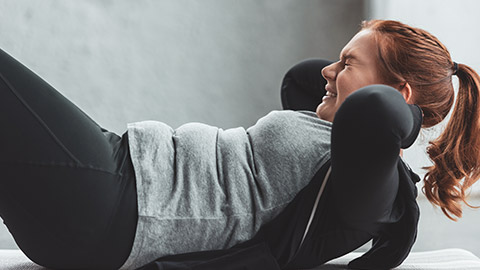In this topic, you will understand how to achieve desirable responses, and build a strong and trusting rapport with your clients through motivation and support while coaching. Additionally, you will learn to recognise and manage undesirable responses. In this topic, we’ll cover:
- Desirable training response
- Undesirable training response

Your goal as a fitness coach is to coach your client effectively and gain desirable training responses. A desirable training response is the positive physiological and psychological changes that occur in response to a well-designed exercise programme. This should incorporate a variety of exercises and training modalities to ensure a well-rounded and balanced approach. Additionally, the programme should be progressive, meaning it gradually increases in intensity and complexity over time, to continue challenging the body and promoting adaptation. Desirable training responses include:
- Improvements in fitness
- Strength, endurance
- Flexibility
- Improved mood
- Self-confidence
- Overall health and quality of life
Building rapport
Building rapport is about creating a strong and trustworthy relationship with your client. At the core of being able to build rapport with your client, you must be client-centred approach. This involves focusing on the needs, preferences, and goals of the client, and tailoring the coaching process to their unique circumstances.
Building rapport with a client is an essential component of effective fitness coaching. When a client feels comfortable and connected with their coach, they are more likely to trust their guidance and stay motivated to achieve their goals.
Here are some ways a fitness coach can build rapport with their client.
- Active listening: By giving your full attention and being present in the moment, you can show your client that you value their input and are committed to understanding their needs and goals.
- Empathy: Showing empathy and understanding towards your client's challenges and struggles can help build a deeper connection and trust. By acknowledging their feelings and validating their experiences, you can create a safe and supportive environment where they feel heard and understood.
- Personalisation: Taking the time to understand your client's unique needs and preferences can help build rapport and trust. By tailoring your coaching approach to their specific goals, fitness level, and personality, you can show that you are invested in their success and are committed to helping them achieve their goals. This principle involves assessing during a fitness test and addressing the client's strengths, weaknesses, and goals to create a programme that is tailored to their specific needs.
- Positive reinforcement: Providing positive feedback and reinforcement can help build rapport and boost your client's confidence. By acknowledging and celebrating their achievements, you can help them feel motivated and supported throughout their fitness journey. Overall, building rapport with a client involves creating a safe and supportive environment where they feel heard, understood, and motivated to achieve their goals.
Watch
Having a structure to a session can really help a trainer provide strong service to their clients. Watch this short tutorial on how to structure a session along with a few example clips on how to open and close a session.
Coaching our clients through resistance training is a crucial and common aspect of our job. Here Ben talks through the NAMEDCAT coaching model which helps structure our coaching process.
See the NAMEDCAT coaching system in action with this example of coaching the barbell back squat.
Motivation and support
There are several types of motivation that a fitness coach can provide to support and coach their clients on their fitness journey. The following table provides some examples of each type of motivation a fitness coach can provide to their client’s.
To achieve desirable training responses, we know that we must follow some effective coaching principles. The following summarises how to accomplish this.
| Type of Motivation | Description | Example |
|---|---|---|
| Intrinsic motivation | This type of motivation comes from within the individual and is driven by personal satisfaction and a sense of accomplishment. | Encouraging a client to focus on how exercise makes them feel, such as the sense of accomplishment after a challenging workout, or the boost in energy they feel throughout the day. |
| Extrinsic motivation | This type of motivation comes from external sources such as rewards, praise, and recognition. | Celebrating a client's achievements with verbal praise, or rewarding them with a small gift or treat for hitting a milestone. |
| Social motivation | This type of motivation comes from social connections and support. | Creating a supportive environment where clients can connect with other like-minded individuals, such as organising group fitness classes or events. |
| Educational motivation | This type of motivation comes from knowledge and understanding of the benefits of exercise and healthy habits. | Sharing educational resources and information about the benefits of exercise, such as explaining the science behind how exercise helps reduce stress and improve mental health. |
| Goal-oriented motivation | This type of motivation comes from setting and achieving specific goals. | Helping a client set a specific goal, such as running a 5K or being able to lift a certain amount of weight, and providing guidance and support to help them work towards achieving that goal. |
Overall, by providing a range of motivational strategies, a fitness coach can help their clients stay motivated and committed to their fitness journey, leading to better outcomes and a more positive experience.
Try it out
Sometimes- to help motivate clients, all you need to do is put yourself in their shoes or perhaps, you can relate. Being relatable and having empathy can guide you in how to handle tricky conversations that will inspire and motivate your client.
Consider your own experiences to better understand what your clients may need from you to stay on track with their training and nutrition.
Isn’t it great to dive into our own minds to discover what drives us towards our goals? What can knock us about and more importantly, how much we can achieve when we don’t give up? In the words of Maya Angelou,
We may encounter many defeats but we must not be defeated.Maya Angelou

In an ideal world, fitness coaching will always have desirable training responses. However, it is unrealistic to never experience undesirable training responses. It is important that you know how to recognise an undesirable training response as well as how to respond to one. Let’s take a look at some of these in detail:
Undesirable training responses: Acute
Acute training responses are the immediate physiological changes that occur during and after a single bout of exercise. These responses may include fatigue, soreness, inflammation, and decreased performance. Acute training responses are typically short-lived and are expected to dissipate within a few hours to days.
The following lists signs you can look out for to identify if your client is having an acute training response:
- Closed body language
- Red face
- In pain/sore
- Nausea
- Negative about workout
- Dizziness
- Avoidance
- Disengaged
- Unconscious/Dead
- Injury
- Pale/Pasty Skin
- Excessive Sweat
- No sweat at all
- Inability to complete
Undesirable training responses: Chronic
Chronic training responses refer to the long-term adaptations that occur over weeks, months, or even years of consistent exercise.
These adaptations may include improved muscular strength and endurance, increased cardiovascular fitness, and changes in body composition.
Chronic training responses are desirable and are the primary goal of most fitness programmes.
However, if the training stimulus is too intense, too frequent, or too prolonged, it can lead to chronic undesirable training responses such as overtraining, injury, and burnout.
These chronic undesirable training responses can result from an imbalance between the training stimulus and the body's ability to recover and adapt. Therefore, fitness coaches need to monitor and adjust the training stimulus to ensure their clients progress towards their goals while minimising the risk of chronic undesirable training responses.
Poor training adaptations

Poor training adaptations refers to an inadequate or negative response to a training stimulus. It can occur when the training programme is not well-designed or the individual does not have the necessary recovery time between workouts. This can result in little or no progress or even decreased performance or physical capacity.
The following lists signs and symptoms of poor training adaptions.
- No improvement/regression
- Negativity towards training
- Lack of commitment
- Chronic Fatigue
- Complaining of soreness/chronic DOMS
- Poor motivation/regularly cancelling sessions
- Struggling to complete workouts
Reasons for negative responses
Both the client and fitness coach can be the cause of an undesirable response has occurred. The following table lists reasons for undesirable training caused by…
| The fitness coach | The client |
|---|---|
|
|
Rectifying poor adaptions
When looking at the training holistically, you can analyse areas that may need adapting to achieve a desirable response. Some actions to rectify poor adaptations may include:
- Look at the overall exercise prescription
- Change frequency
- Change intensity
- Change duration
- Change the type of exercise
- Try to find common ground with the client
- Doctor/Physio referral
- Give more education in other areas
- Stress
- Nutrition
- Sleep
- Accommodate for their changed circumstances
- Look at screening/testing procedures
- Re-test, re-interview if necessary
- Look in the mirror, ask yourself, “is there anything else I could do to improve the sessions?”
Other undesirable responses
The following is a list of other undesirable responses that may impact your client while you are coaching.
- Client nervous/intimidated
- Too hot/humid/windy/wet
- Lack of an appropriate warm-up
- Poor nutrition
- Malnourished
- Eaten too close to workout
- Hungover
- Drunk
- Dehydrated
- Too much caffeine
- Sick/Ill
- Lack of sleep
- External stress
- FITT Principles mismanaged by trainer:
- Too close together
- Too intense
- Too long
- Too advanced
- Poor screening process
- Undisclosed medical condition
- Misinterpretation of fitness levels/exercise history
- Session not specific to client goals
Responding to undesirable responses
Many strategies can provide a solution to this problem. Look at the following list to help you decide which action should be taken, depending on the type of undesirable response you are dealing with.
- Reassurance/chat with them
- Lower the intensity
- Better monitoring processing
- Education on session preparation
- Change location
- Fanning them/cooling them down
- Altering the session based on client's state
- Recovery position
- Administer first aid
- Stop the session
- Regress the exercises/scale
- Better screening process
- Refer to Doctor/Physio
- Drink water/ingest carbohydrates
